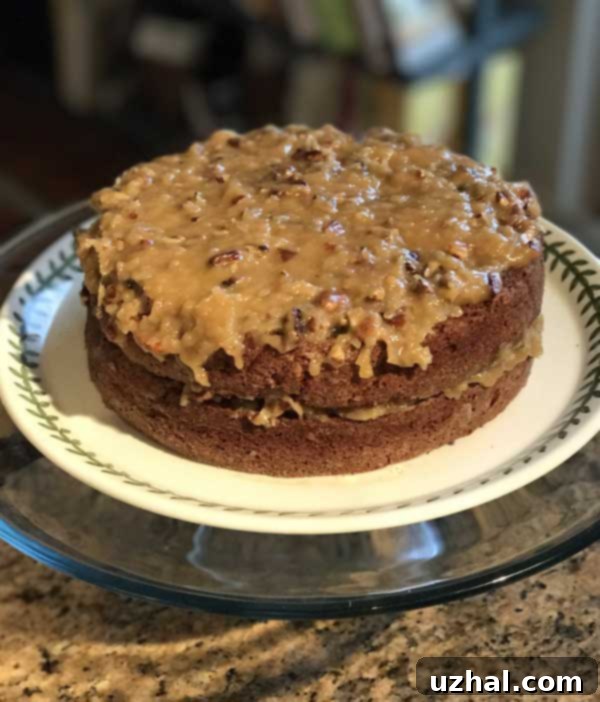Perfectly Portioned: Mastering the Small German Chocolate Cake Recipe with Toasted Pecan-Coconut Frosting
The quest for the ideal German Chocolate Cake often begins with a classic recipe, perhaps one from an old, esteemed collection like the Time Life Series. Recently, a fellow baker, Sue, and I embarked on just such a culinary adventure. We meticulously followed a traditional German Chocolate Cake recipe, and while the flavor of the cake itself was undeniably delicious and deeply satisfying, its aesthetic left something to be desired. The original icing, which incorporated melted chocolate, created a somewhat monochromatic appearance, muting the distinctive contrast that makes German Chocolate Cake so visually appealing. We agreed: the taste was superb, but the presentation needed a fresh approach. Inspired by its incredible flavor, I decided to revisit the recipe, reimagining it with a new presentation and a more manageable size.
This led to the development of a delightful small German Chocolate Cake, a recipe designed for those who appreciate the rich flavors of this classic dessert but prefer a more modest serving size. This version is not just scaled down; it’s refined. Recognizing the desire for a lighter, more vibrant look, I opted for a non-chocolate coconut-pecan icing. This change not only brightens the cake’s appearance but also allows the intricate flavors of the toasted pecans and sweet coconut to truly shine without being overshadowed by additional chocolate in the frosting. The addition of a touch of brown sugar in the icing further enhances its depth, introducing a subtle caramel note that complements the cake’s cocoa base beautifully. The pecans are toasted to perfection, unlocking their full nutty aroma and a satisfying crunch that contrasts wonderfully with the moist cake layers.
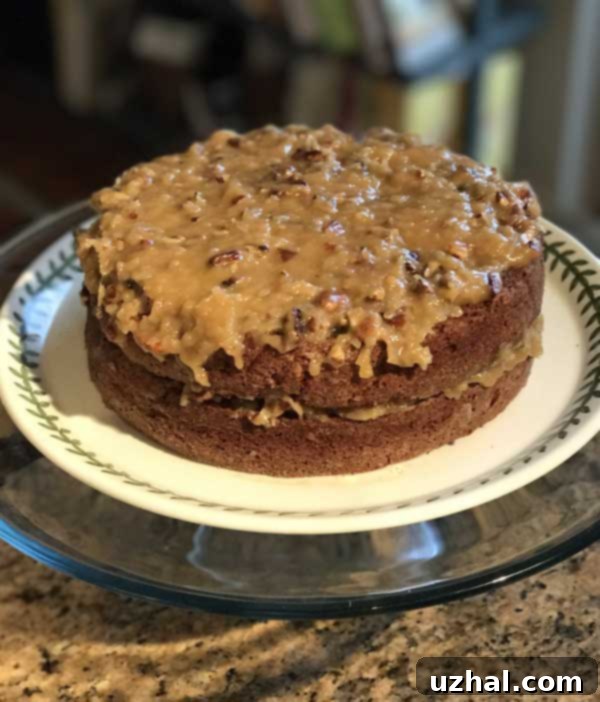
Crafting the Perfect Small German Chocolate Cake
This recipe is essentially a scaled-down adaptation of that beloved Time Life classic, halved to produce a perfectly portioned cake, ideal for smaller gatherings or simply when you crave a slice of homemade goodness without committing to a massive three-layer creation. While the core ingredients remain true to the original’s spirit, I’ve adjusted the method slightly to optimize for a two-layer, 8-inch cake, ensuring both ease of preparation and superior results. The non-chocolate coconut-pecan icing is the star of this adaptation, delivering that iconic flavor profile with a delightful textural contrast. I purposefully toasted the pecans to intensify their flavor and added a hint of brown sugar to the icing for an extra layer of richness and depth.
The icing recipe provided below is meticulously balanced to generously cover both the top and bottom layers of an 8-inch round cake. If your preference leans towards a fully frosted cake, with sides completely enveloped in this luscious topping, you can easily double the icing quantities. I highly recommend trying this recipe, especially if you’re seeking a more manageable German Chocolate Cake. Most traditional recipes yield imposing three-layer cakes, which can be daunting for home bakers or excessive for typical household consumption. This smaller, two-layer version strikes a perfect balance. Furthermore, for those who adore the distinct flavor of German Chocolate Cake but desire an even simpler approach, this batter can be baked in a 9-inch square pan, yielding a wonderfully moist and flavorful sheet cake that’s easy to slice and serve. Do share your experiences if you bake it!
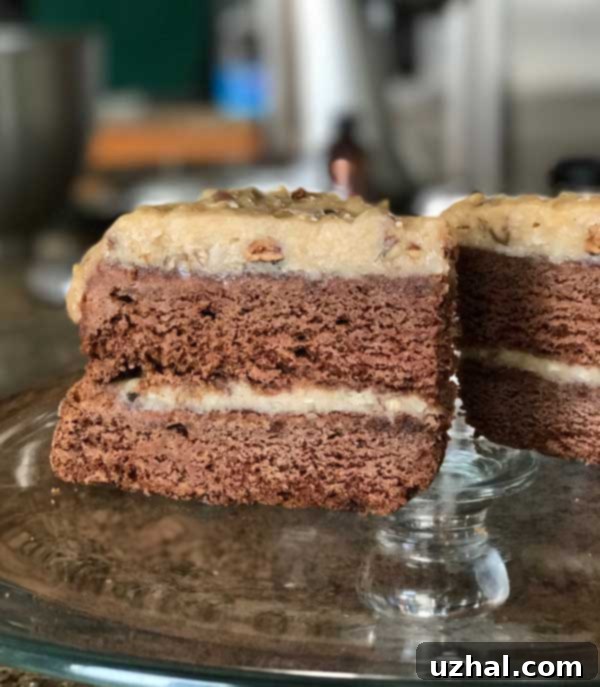
Since first sharing this small German Chocolate Cake recipe, it has become a staple in my kitchen. I’ve baked it multiple times, consistently using two 8-inch round pans, which results in a cake of perfect dimensions for my needs – not too grand, yet satisfyingly substantial. Its smaller size also makes it incredibly versatile for meal planning and enjoyment. I frequently bake a batch, slice the cooled cake in half, and then freeze one half for later enjoyment. This means I can always have a delicious, homemade dessert on hand, ready to thaw and savor whenever a craving strikes. The slice you see in the photo above, for instance, was still partially frozen, testament to this convenient freezing method. Rest assured, it thawed to perfection, ready to be enjoyed as a decadent dessert, offering all the classic flavors of German Chocolate Cake in a more practical, home-friendly format. This method ensures that the effort put into baking is rewarded with prolonged enjoyment, making homemade treats more accessible and less wasteful.
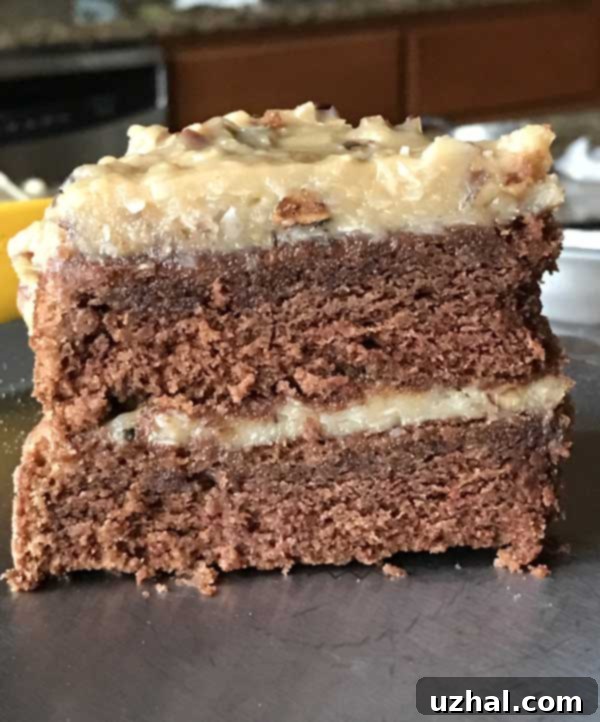
Small German Chocolate Cake Recipe
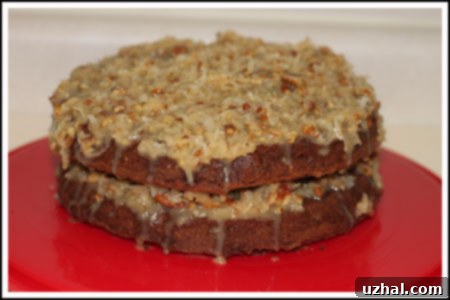
Small German Chocolate Cake
Recipe by Cookie Madness
Pin Recipe
Ingredients
For the Cake:
- ¼ cup water
- 3 oz German’s sweet chocolate coarsely chopped
- 1 ¼ cups cake flour sifted before measuring (approx. 5.25 oz)
- ½ teaspoon baking soda
- ¼ teaspoon salt
- 2 large eggs separated, at room temperature
- ¾ cup plus 2 tablespoons sugar divided use
- 4 oz unsalted butter softened to room temperature
- ¾ teaspoon vanilla extract
- ½ cup buttermilk at room temperature
For the Icing:
- 6 tablespoons unsalted butter
- ½ cup granulated sugar
- ¼ cup brown sugar lightly packed
- 2 large egg yolks lightly beaten with a fork
- ¾ cup evaporated milk
- ¾ teaspoon vanilla extract
- 1 pinch of salt
- ¾ cup chopped toasted pecans
- 3 ½ oz sweetened shredded coconut by weight
Instructions
-
Begin by preparing the chocolate for the cake batter. In a small saucepan, or a large microwave-safe measuring cup, bring the ¼ cup of water to a boil. Once boiling, remove it immediately from the heat and add the coarsely chopped German’s sweet chocolate. Stir continuously until the chocolate is completely melted and the mixture is smooth and glossy. Set this aside and allow it to cool for approximately 20 minutes; it should be lukewarm, not hot, when incorporated into the batter.
-
While the chocolate is cooling, preheat your oven to 350 degrees F (175 degrees C).
-
Prepare your cake pans to prevent sticking and ensure easy release. Lightly grease two 8-inch round cake pans. For an extra layer of protection, line the bottoms of the pans with circles of wax paper or parchment paper. Once lined, grease the paper again and lightly dust the entire interior of the pans with flour, tapping out any excess. Proper pan preparation is key for beautiful cake layers.
-
In a separate medium bowl, combine the dry ingredients for the cake: the already-sifted cake flour, baking soda, and salt. Whisk these together thoroughly to ensure they are evenly distributed. Sifting the cake flour before measuring is crucial for a light and tender crumb.
-
Now, prepare the egg whites. In the clean bowl of a stand mixer fitted with the whisk attachment, whip the room-temperature egg whites until they form soft peaks. Gradually add 2 tablespoons of the measured sugar (from the ¾ cup plus 2 tablespoons portion), continuing to beat until the peaks are almost stiff and glossy. Carefully scrape these whipped egg whites into a separate, clean bowl and set aside. This step incorporates air, making the cake light and airy.
-
Using the same mixer bowl (no need to clean it if you just whipped egg whites), switch to the paddle attachment. Cream the softened unsalted butter with the remaining sugar (¾ cup) until the mixture is light, fluffy, and pale in color. This creaming process aerates the butter and sugar, contributing to the cake’s tender texture. Beat in the egg yolks, one at a time, ensuring each is fully incorporated before adding the next. Follow with the vanilla extract, beating well and scraping down the sides of the bowl as needed to ensure everything is mixed evenly. Turn the mixer to its lowest speed and slowly incorporate the cooled melted chocolate mixture. Finally, with the mixer still on its lowest speed or by hand, alternately add the flour mixture and the buttermilk to the batter, beginning and ending with the flour mixture. Mix just until combined, being careful not to overmix, which can lead to a tough cake.
-
To lighten the batter, fold about ⅓ cup of the cake batter into the whipped egg whites. This helps to temper the egg whites and make the folding process easier. Then, gently fold the egg white mixture into the main batter, using a spatula to incorporate it without deflating the air. The goal is to keep the batter as light and airy as possible.
-
Evenly divide the prepared batter between the two 8-inch cake pans. Bake in the preheated oven for 28-30 minutes. Begin checking for doneness a few minutes early by inserting a toothpick into the center of the cakes; it should come out clean. Once baked, remove the cakes from the oven and let them cool in their pans for about 5 minutes before inverting them onto a wire rack. Carefully peel off the parchment paper from the bottoms and allow the cakes to cool completely on the rack before frosting.
-
Now, prepare the luscious coconut-pecan frosting. In a heavy-bottomed saucepan (a 3-quart size works perfectly to prevent overflow), melt the 6 tablespoons of unsalted butter over medium-low heat.
-
While the butter melts, whisk together the granulated sugar, brown sugar, and lightly beaten egg yolks in a separate bowl. Once the butter is melted, remove the saucepan from the heat and immediately whisk in the egg yolk mixture, followed by the evaporated milk. Return the saucepan to low to medium-low heat and cook, stirring constantly with a whisk or rubber spatula. This continuous stirring is vital to prevent scorching and ensure the yolks cook properly without scrambling. Continue cooking until the mixture thickens significantly and begins to bubble, usually taking 5 to 10 minutes. For me, it consistently thickens perfectly around the 5-minute mark.
-
Once thickened, immediately pour the hot mixture through a fine-mesh strainer into a clean, heatproof bowl. This step ensures a silky-smooth icing, free of any small cooked egg bits. Stir in the vanilla extract and a pinch of salt. To prevent a skin from forming, lay a small piece of parchment paper directly on the surface of the icing, as you would with pudding. Let the icing cool at room temperature for about 40 minutes. After this initial cooling period, stir in the chopped toasted pecans and sweetened shredded coconut. Transfer the bowl to the refrigerator to chill and further thicken. This chilling process is crucial and typically takes a few hours. The icing needs to be firm enough to hold its shape on the cake.
-
To assemble your small German Chocolate Cake, ensure both cake layers and the icing are completely cooled. Place one cake layer on your serving plate or cake stand. Generously spoon about half of the prepared coconut-pecan icing over the top, spreading it evenly to the edges. Carefully place the second cake layer on top. Spoon the remaining icing over the second layer, spreading it out to create an appealing, rustic look or gently pushing some over the sides if you prefer a partial drip effect. Slice and serve!
Notes
Baking this small German Chocolate Cake is a rewarding experience, transforming a classic dessert into a more approachable and versatile treat. The cake’s moist, rich chocolate layers, paired with the gloriously nutty and sweet coconut-pecan frosting, create a symphony of flavors and textures that is truly irresistible. Whether you’re an experienced baker or just starting, this recipe offers a chance to create a dessert that will impress both in taste and presentation. The joy of a perfectly baked cake, especially one that fits your needs so precisely, is immeasurable.
We encourage you to try this adapted recipe. It’s a testament to how slight modifications can greatly enhance both the practical appeal and the visual charm of a beloved classic. The distinct flavors of toasted pecans and sweet coconut, balanced with a hint of brown sugar, provide a memorable taste experience that stands out. Remember, baking is an art form, and every attempt is a step towards perfection. Don’t hesitate to share your baking journey with us, including any adjustments or personal touches you add. Happy baking!
